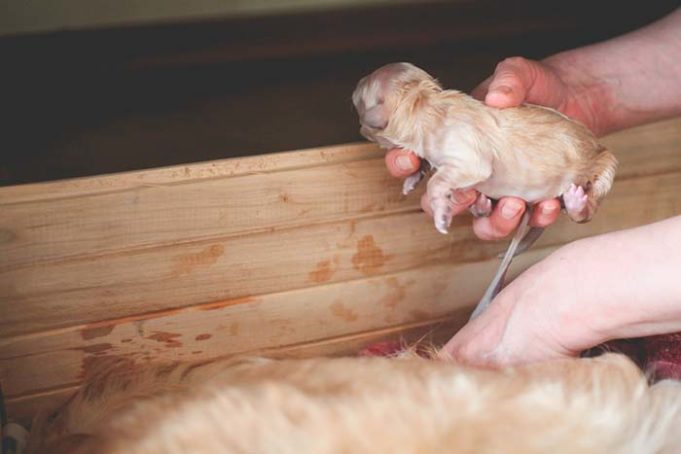Helping a dog to give birth is a very serious process that sometimes comes inherent with potential problems and unexpected issues. Below is a list of potential dog labor complications that can occur during this time so you know what to expect and possibly have a vet present just in case.
ALSO READ: 7 Tips on How to Prepare for Your Dog’s Pregnancy
8 Dog Labor Complications
1. Dystocia
Commonly termed obstructed labor in dogs, meaning the puppy is not able to get out of birthing canal without assistance from a person, due to either the way the puppy is placed in the birth canal or because of some kind of obstruction, such as an intestinal obstruction that is reducing the overall size of the birth canal.
Or the female dog’s pelvis could be too small to allow the puppy to pass through.
2. Amniotic Sac and Umbilical Problems
When a dog gives birth, the puppies come out still enclosed in the amniotic sac, and the mother of the puppies must open the sac quickly and effectively with her mouth and also chew off the attached umbilical cord, while also making sure not to injure her pups.
However, a mother dog may not do this due to exhaustion or due to not knowing how to, or that she should do this, especially if it is her first time giving birth.
If the birth does not happen at a veterinary clinic, you, the dog’s owner (or whoever is present at the time of the birth), must open the amniotic sac.
From there you need to remove the pup from the fluid, and carefully cut their umbilical cord, and gently rub the puppy to ensure that he or she is breathing.
All of this must be done safely, gently, and always with clean instruments.
3. Puppy Cannot Breathe
 The puppy’s mother will also stimulate the newborn pup to start breathing on its own by licking the puppy clean.
The puppy’s mother will also stimulate the newborn pup to start breathing on its own by licking the puppy clean.
She will do this on her own if she is not too tired from labor, and knows that this is what she needs to do.
If mother dog does not do this and the pup does not start breathing right away, within the first several minutes after birth, it will not survive.
And the human who is present during birth will need to gently wrap the puppy in a warm blanket, and carefully massage the puppy in hopes of stimulating breathing, while making sure not to crush the puppy or damage them in any way.
4. Brachycephalic Breeds
This is a preventable problem that is 100% caused by human interventions in natural dog breeding, resulting in malformation of certain parts of the body in puppies of the dogs being made to breed.
The malformation is often in the snout of the dog, which leads to problems with their cardiac and respiratory systems.
Often seen in Pugs, Bulldogs, and French Boxer breeds.
Commonly, these breeds cannot have natural labor and require a scheduled and costly cesarean section be performed by a licensed doctor of veterinary medicine (DVM).
If not, you risk the mother and all of her pups dying due to difficulties with breathing while in labor as well as the inability to pass the abnormally large heads of these breeds of dogs through the abnormally small birth canals that they also often have.
RELATED: Dog Pregnancy Stages and What to Expect When Expecting
5. Reperfusion Injury
This happens less commonly, and only after the puppies have all been delivered, but the mother is still bleeding excessively.
It is a severe complication that cannot be addressed at home and the mother dog will have to be taken to an emergency veterinary clinic, immediately.
6. Uterine Rupture
This is another uncommon dog labor complication, but if it happens it can cause the mother dog and her puppies to lose their lives.
One of the common causes of this is the puppies being heavy and putting excessive pressure on their mom’s uterus.
Sometimes the uterus will not rupture completely and instead swell, resulting in her birth canal being restricted and not allowing the puppy to pass through it.
In these cases, an emergency vet will need to be called to the home if the mother dog is not already at a veterinary clinic.
7. Cesarean and Postoperative Problems
Because a cesarean procedure involves the dog being put under anesthesia, there are risks for complications to occur due to the dog being put under.
Also, infection can develop at the site of the cesarean section and hemorrhages are also possible, as well as post-operation complications.
All of those complications are fairly uncommon, and even less likely to occur if the mother dog is healthy and well taken care of prior to and during her pregnancy.
8. Diseases Prior to Whelping
 If a dog is unhealthy or ill before or during her pregnancy, complications with her and her puppies are very likely.
If a dog is unhealthy or ill before or during her pregnancy, complications with her and her puppies are very likely.
This is because the mom dog is such a weak state that she is unable to give birth to the puppies and also because she could pass her sickness to her puppies, in utero.
It is necessary to discuss a mother dog being sick before or during her pregnancy with a licensed doctor of veterinary medicine.
To prevent dog labor complications:
- Research, research, research
- Pay close attention to your dog
- Know what stage of pregnancy your dog is in
- Take your dog to see a vet during her pregnancy
- Have all the supplies prepared and ready during whelping
- If possible, have a veterinarian present during whelping
- Do not intervene in the natural process unless absolutely necessary
READ NEXT: 15 Tips on Dog Pregnancy and Whelping to Help You Through the Process













